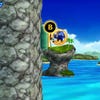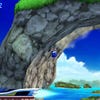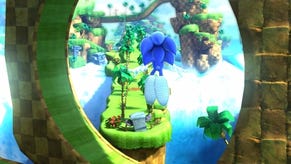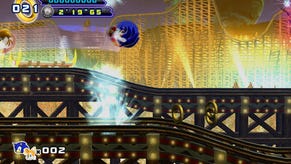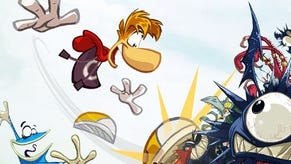Sonic Generations 3DS Review
Running on the spot.
Green Hill casts a long shadow over Sonic Generations on the 3DS. On the 20th anniversary of a series that has lost its way more than once, with each new release promising that this time, no really, this time the old magic will be recaptured, it's appropriate and yet slightly defeatist to open with the same stage that resonates so strongly for so many fans.
This is the Sonic we mean when we pine for the glory days of the blue hedgehog; a rollercoaster of verdant slopes and dizzying spins, rewarding players for taking the high road or the low road, and giving the sedate platform genre a much-needed red sneaker up the arse in the process.
It's a legacy that the series has struggled to live up to, and it's notable that the brightest moments of Generations' 3DS incarnation come in the first three stages, which recreate not only the iconic Green Hill Zone but also Casino Night from Sonic 2 and Mushroom Hill from Sonic & Knuckles. It's thrilling and comforting to revisit these beautifully designed courses, their familiar contours refreshed by a crisp 3D makeover.
Control is perhaps a little spongy on the control stick, while the minuscule d-pad never feels robust enough for the sort of fast action the game demands, but it's an otherwise excellent recreation of some seminal gaming moments. The visuals are a delight, with the different planes of Sonic's 2D world slipping into 3D very nicely. The relatively small screen of the 3DS can be an issue, sometimes reducing Sonic to less than a centimetre in height, but few fans will complain
But then the birthday party rolls on, introducing stages that weren't seen in the beefier console versions of the game. There's thankfully nothing from the 2006 Sonic the Hedgehog travesty here, but Emerald Coast and Radical Highway stages reimagined from both Sonic Adventures, plus Sonic Rush's Water Palace and the Tropical Resort from Sonic Colors, show a definite dip in quality all the same.
That's not the fault of the original games, which are among the best of the modern-era Sonic titles; it's down to the way they've been reworked for this particular version. The concept is the same as the 360 and PS3 version of the game - classic Sonic and modern Sonic take it in turns to tackle a compilation of stages from previous games - but here the hub world of the console game is replaced with a simple two-act choice per stage: Act I features Classic Sonic, Act II his modern counterpart. Clear those and a bonus stage is unlocked, along with access to the next locations.
Once you get past the recreations of the beloved 16-bit stages, however, things take a nosedive. Most of all, it shows how the clarity of vision that brought us Green Hill has eluded Sonic Team and handheld developer Dimps in recent years. Sonic hurtles along, propelled by buffers and springs rather than the player, until you run into spikes or an enemy dropped in your path. Sometimes a drop will lead to another layer below, or a cushioning updraft that buoys you back into action. Other times you'll just die instantly. The spectre of unfair instant death haunts the later stages, making them a pain to explore.
The game even fudges the central idea of using two generations of Sonic. There's precious little difference between the design of the Classic and Modern stages, bar a few more gimmicks and gizmos and a bias towards speed over exploration in the latter. Ironically for the one version of the game that's actually in 3D, the more ambitious three-dimensional moments of the Modern stages have been hammered flat until they're really just slightly different side-on stages in the traditional Sonic style, albeit with worse design.
Even more bewildering, Classic Sonic is given Modern Sonic's homing attack once the Megadrive-inspired stages are finished, blurring the difference between them until both characters and stages become virtually interchangeable.
Such a reductionist approach to the Sonic legacy is perhaps understandable given the restrictions of handheld gaming, but the 3DS version of Generations still feels incredibly slight when compared to the bigger consoles. It takes only a few hours to clear the game's 14 stages, while the handful of boss stages (races for Classic Sonic, battles for Modern) range from uninspired to surprisingly good.
Long-term value presumably comes from the urge to get an S Class ranking on every level and the chance to unlock bonus missions where, for example, you're challenged to complete a stage without hitting any enemies or losing any rings. There's also online and local multiplayer, where you can compete for the best ranks. However, as these all draw from the same small pool of stages, the effect is to spread the game even more thinly rather than bulking it up.
At the risk of reviving an old rivalry, you only have to look at the constantly inventive Super Mario 3D Land to see how much better Sonic Generations could have been on the 3DS. Where Mario playfully remixed his own iconography to create something that felt both familiar and fresh, Sonic still seems stuck harking back to his successful past at the expense of a less certain and less popular present; a fading star with only a handful of early hits to fall back on. While a canny rocker would save the crowd pleasers for the encore, Sonic's greatest hits appear here at the start of the game, racing through the gracefully designed pathways of Green Hill, Casino Night and Mushroom Hill.
There's no denying that time spent in those stages is a pleasure, particularly in 3D. But with the glory days picked clean, all that remains is a short, disappointing downhill slide through clumsy and frustrating renditions of more modern, characterless stages. Drooping from joyous classic to dissatisfying mediocrity in just a few hours of gameplay, Generations on the 3DS provides a surprisingly handy microcosm of Sonic's decline over the years. Not the best anniversary present, then.





